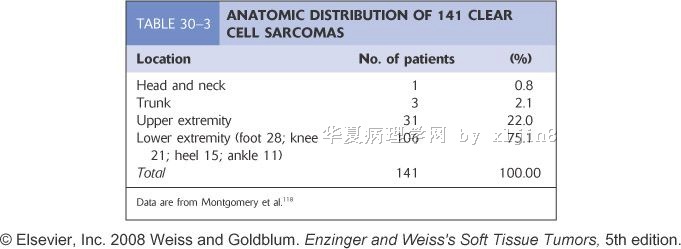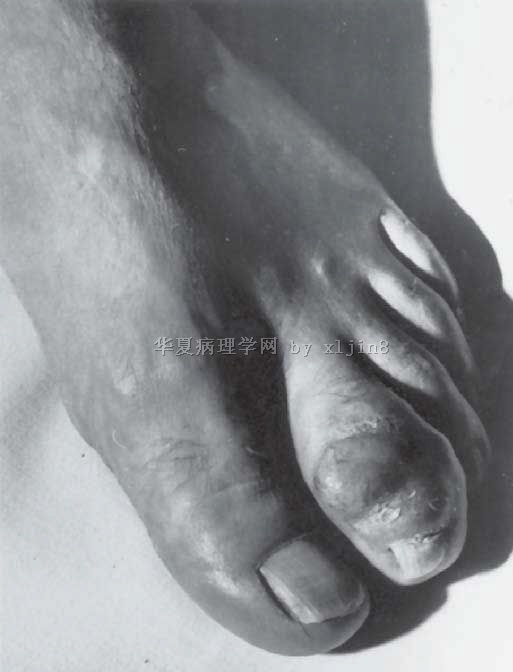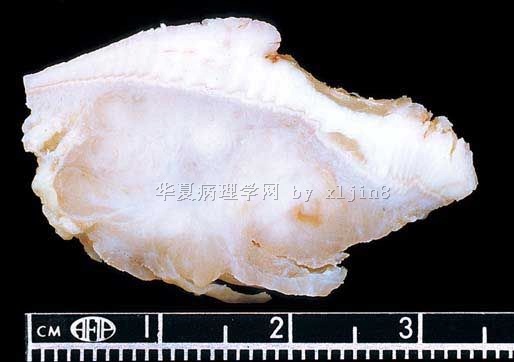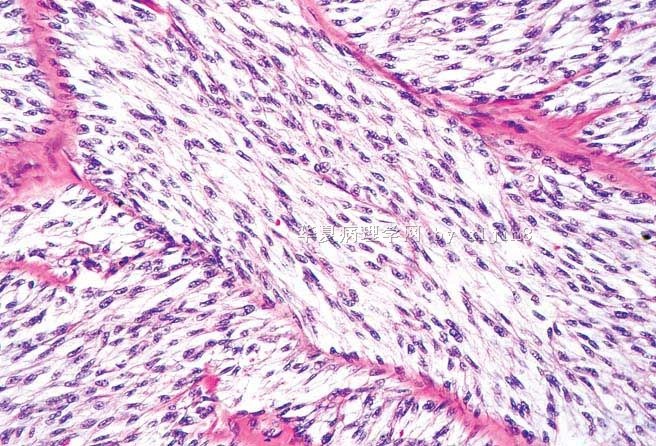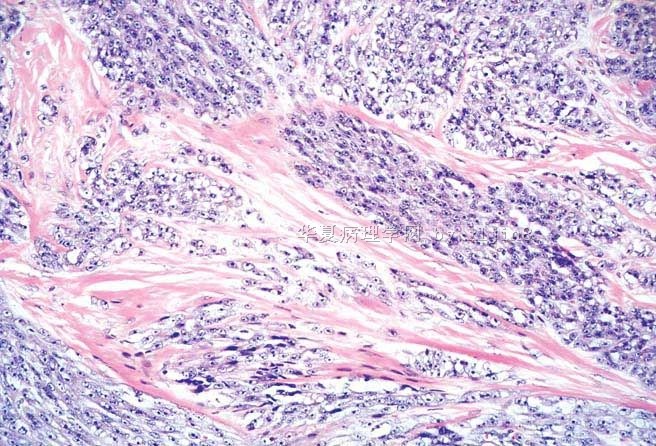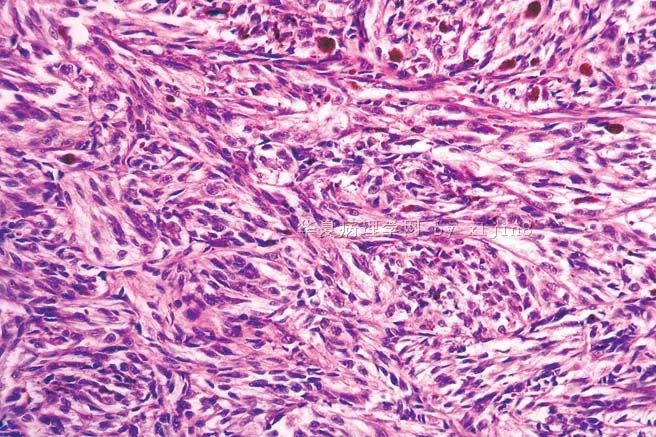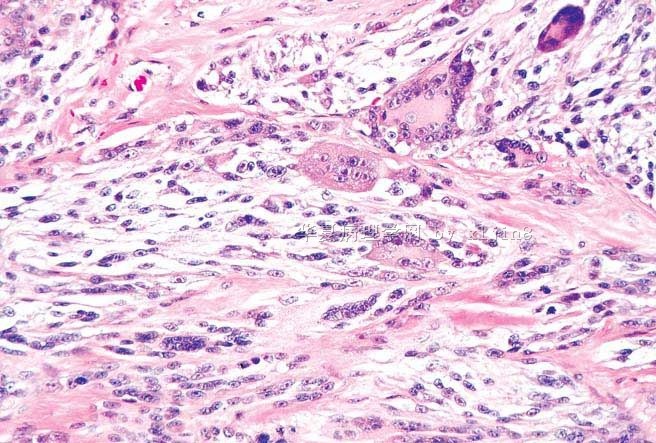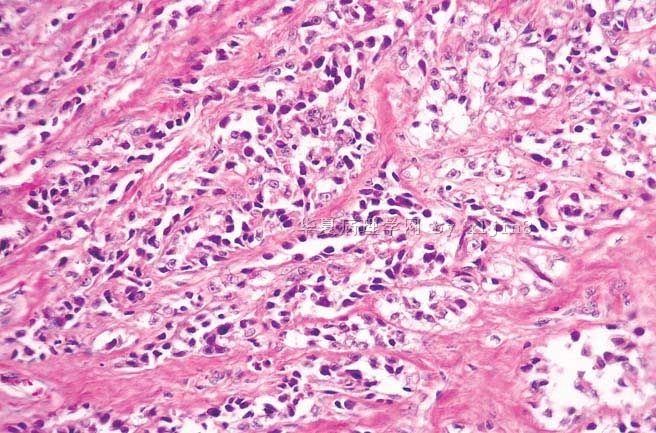| 图片: | |
|---|---|
| 名称: | |
| 描述: | |
- 软组织透明细胞肉瘤的鉴别诊断讨论(附Enzinger & Weiss's 软组织肿瘤5版中的CCS图谱)
Cutaneous Clear Cell Sarcoma: A Clinicopathologic,Immunohistochemical, and Molecular Analysis of 12 Cases Emphasizing its Distinction from Dermal Melanoma
Markus Hantschke, MD,* Thomas Mentzel, MD,* Arno Ru¨ tten, MD,* Gabriele Palmedo, PhD,* Eduardo Calonje, MD,w Alexander J. Lazar, MD,z and Heinz Kutzner, MD*
(Am J Surg Pathol 2010;34:216–222)
该文中作者讨论中提到免疫组化在二者的鉴别诊断中没有价值,但有一些组织形态学可以区分:透明细胞肉瘤在整个肿瘤中索性细胞呈一致的束状排列,其间由纤细的纤维分隔,间质大多数透明硬化和网状。而黑色素瘤病变内不止一种细胞形态。多核巨细胞在这2种病变中均可存在,但在CCS中较散在,核位于周边呈花环状,形态较一致,而黑色素瘤中多核巨细胞分布无规律,且核多形性。如有条件,进行EWS-ATF1和EWS-CREB1检测非常有价值。
-
本帖最后由 于 2010-03-26 06:25:00 编辑
| 以下是引用xljin8在2010-3-26 6:06:00的发言: 原文摘要 Clear cell
sarcoma (CCS) of tendons and aponeuroses/malignant melanoma (MM) of of primary
CCS of the gastrointestinal tract that may have a variant fusion gene and there
was a female predominance (10 females, 2 males). Most tumors (n = 9) All cases
showed uniform nests and fascicles of pale spindled or slightly pattern was
confirmed in all cases by fluorescence in situ hybridization. Local
Lyle PL, Amato CM, Fitzpatrick JE, Robinson WA. Gastrointestinal melanoma or clear cell sarcoma? Molecular evaluation of 7 cases previously diagnosed as malignant melanoma. Am J Surg Pathol. 2008;32:858-66. pleomorphism.
Occasional cases show pleomorphism, high mitotic index, and/or EWS/ATF1
fusion transcript. This translocation has never been documented in cases of
primary GI CCS with the t(12;22) translocation. We used reverse-transcription
polymerase chain reaction and fluorescence in situ histories
of cutaneous MM, and 1 with an anal MM. All 4 cases for which there was |

- xljin8
-
本帖最后由 于 2010-03-29 05:11:00 编辑
鉴别诊断
由于细胞学指标是诊断CCS最主要的特征,肿瘤组织保存差或变性时,肿瘤细胞皱缩、黏附在纤维条束上,很容易被误诊为其他圆形细胞肉瘤,特别是腺泡状横纹肌肉瘤。因此,必须评价组织保存最好的区域。
对于形态保存好的肿瘤,鉴别诊断要考虑二个方面,一个方面与具有明显纤维束状构型的肉瘤鉴别,如纤维肉瘤、滑膜肉瘤和恶性周围神经鞘肿瘤鉴别;另一方面与产生黑色素的肿瘤鉴别,如富于细胞的蓝痣、皮肤结节型恶性黑色素瘤。
CCS独特的细胞学特点包括1)明显的黑色素瘤样核仁;2)透明细胞质;3)免疫表型特征,这些特点可区别于上述梭形细胞肉瘤。
CCS与黑色素产生细胞肿瘤的鉴别较为困难,更多的需要组织学、临床、和分子资料。一般讲,CCS最初发生在深部软组织,一般不累及真皮,无皮肤黑色素病变。肿瘤由非常明显的和相当一致性的纺锤形或胖梭形细胞构成。而皮肤结节性恶性黑色素瘤的构成为多样性,常常出现上皮样和多形性细胞。但当临床和形态学介于二者之间时,只能通过基因分析来鉴别。t(12;22)易位仅出现在CCS。
其他鉴别诊断包括富于细胞篮痣、副节瘤样真皮黑色素细胞肿瘤、GI透明细胞肉瘤样肿瘤(clear cell sarcoma - like tumor of gastrointestinal tract)。CCS-LTGI主要发生在小肠,其次胃和结肠,形态学与CCS有些相类似,不同处为肿瘤中出现破骨样巨细胞、S-100+、很少或无黑色素、不表达黑色素标记、无t(12;22) 易位。

- xljin8
-
yoyo751102 离线
- 帖子:303
- 粉蓝豆:79
- 经验:489
- 注册时间:2007-08-20
- 加关注 | 发消息

